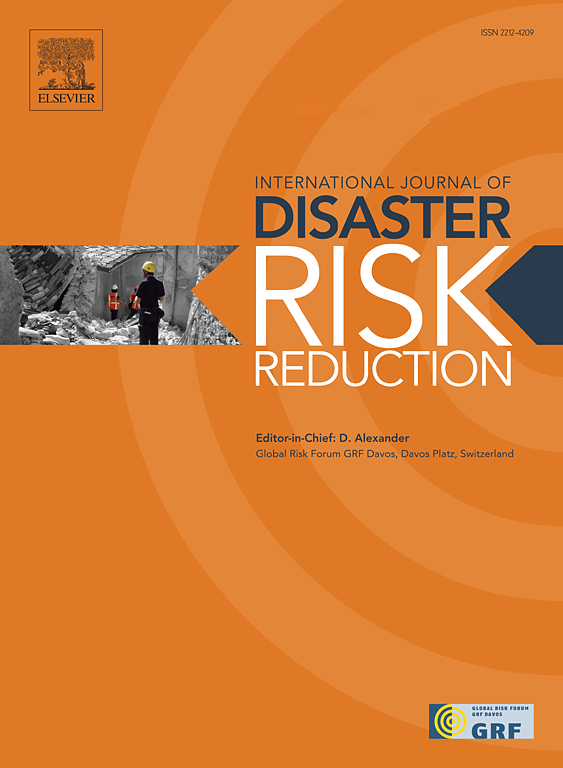一个专家系统,量化花园的野火危害,创造有效的防御空间
IF 4.2
1区 地球科学
Q1 GEOSCIENCES, MULTIDISCIPLINARY
International journal of disaster risk reduction
Pub Date : 2025-04-15
DOI:10.1016/j.ijdrr.2025.105424
引用次数: 0
摘要
野火正在全球范围内造成越来越多的房屋损失,尤其是在荒地和城市交界的地方。尽管现有的指导方针过多地帮助在花园中创建可防御的空间并保护房屋免受野火的侵害,但量化风险仍然是一个研究前沿。我们根据最近对可防御空间指南的全球审查设计了一种评估方法,并根据燃料类型、数量和空间安排确定了危险。我们在南塔斯马尼亚(澳大利亚)的32个花园进行了评估试验。我们使用专家系统将调查数据结合起来,计算危险分数,考虑燃料特性之间的相互作用,并使用敏感性分析根据对危险分数的影响对单个危险进行排名。园林植物种类较多(N = 374),其中72%为澳大利亚外来植物。最常见的危害是房屋附近的物体,以及植物覆盖、花园垂直结构和整个防御空间中植物的可燃性。大多数花园的总体风险得分为“中等”(N = 15)或“高”(N = 13),只有两个被评为“低”,一个被评为“非常高”。敏感性分析确定了植被特征——覆盖、位置和浇水状况——以及防火元素的存在,作为对总体危害评分影响最大的单个变量。所提出的方法量化了花园内的火灾危险,提供了灵活的解决方案来支持指南的实施,并促进了不同地理环境的比较。本文章由计算机程序翻译,如有差异,请以英文原文为准。
An expert system to quantify wildfire hazards in gardens and create effective defensible space
Wildfires are causing increased house loss worldwide, especially at the wildland-urban interface. Despite the existing plethora of guidelines to help creating defensible space in a garden and protect houses from wildfire, quantifying risk remains a research frontier. We designed an assessment method based on a recent global review of defensible space guidelines and identified hazards based on fuel type, amount, and spatial arrangement. We trialled the assessment in 32 gardens located in southern Tasmania (Australia). We combined survey data using an expert system enabling calculation of hazard scores that accounts for the interaction between fuel characteristics and used sensitivity analysis to rank individual hazards based on their impact on hazard score. Gardens included a high number of plant taxa (N = 374), 72 % of which were exotic to Australia. The most common hazards were represented by material objects close to the house, as well as plant cover, garden vertical structure, and flammability of plants across the whole defensible space. Most gardens achieved an overall ‘Moderate’ (N = 15) or ‘High’ (N = 13) hazard score, with only two classified as ‘Low’ and one as ‘Very High’. Sensitivity analysis identified vegetation characteristics – cover, location, and watering status – as well as the presence of fire-protective elements as the individual variables with the highest impact on overall hazard score. The proposed method quantifies fire hazards within gardens, provides flexible solutions to support guideline implementation, and facilitates comparisons across different geographic settings.
求助全文
通过发布文献求助,成功后即可免费获取论文全文。
去求助
来源期刊

International journal of disaster risk reduction
GEOSCIENCES, MULTIDISCIPLINARYMETEOROLOGY-METEOROLOGY & ATMOSPHERIC SCIENCES
CiteScore
8.70
自引率
18.00%
发文量
688
审稿时长
79 days
期刊介绍:
The International Journal of Disaster Risk Reduction (IJDRR) is the journal for researchers, policymakers and practitioners across diverse disciplines: earth sciences and their implications; environmental sciences; engineering; urban studies; geography; and the social sciences. IJDRR publishes fundamental and applied research, critical reviews, policy papers and case studies with a particular focus on multi-disciplinary research that aims to reduce the impact of natural, technological, social and intentional disasters. IJDRR stimulates exchange of ideas and knowledge transfer on disaster research, mitigation, adaptation, prevention and risk reduction at all geographical scales: local, national and international.
Key topics:-
-multifaceted disaster and cascading disasters
-the development of disaster risk reduction strategies and techniques
-discussion and development of effective warning and educational systems for risk management at all levels
-disasters associated with climate change
-vulnerability analysis and vulnerability trends
-emerging risks
-resilience against disasters.
The journal particularly encourages papers that approach risk from a multi-disciplinary perspective.
 求助内容:
求助内容: 应助结果提醒方式:
应助结果提醒方式:


